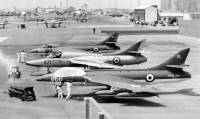Hawker Hunter - Survivor WT723 (ex G-PRII)
PR.11 WT723 - SCC Technology Campus (displayed), Tyseley, Birmingham
 |
Hunter PR.11 WT723 at Tyseley, 14th May 2023; Damien Burke




Built as part of the first production batch of the F.4, WT723 first flew on 16th February 1955 and was delivered to 5 MU the next month. Serving with 54(F) and 14(F) Squadrons plus 229 OCU, she was returned to Hawkers and converted to a GA.11, being delivered to the FAA on 17th August 1962. She served with 764 NAS and was converted to a PR.11 with the fitment of nose cameras during that time. In 1973 she joined FRADU at Yeovilton and spent the next 20 years with them before being retired in 1993.
After 3 years as a ground handling airframe at Culdrose she was sold to a US buyer, and overhauled by Exeter-based Classic Jets. The plan to fly her in the US never came to anything, so she became G-PRII and was then purchased by Belgium-based Classic Fighters, who briefly operated her on the airshow circuit in Europe. WT723 thus became the only remaining flyable example of the PR.11, but sadly with the demise of Classic Fighters around 2002, she was grounded for several years.
Eventually rescued by a new owner and returned to the air in 2008 by Hunter Flying Ltd. at Exeter, she also gained a new paint scheme - Black Arrows colours - not awfully appropriate to her history, but marking the 50th anniversary of the famous 22-Hunter loop. She appeared at the 2008 Farnborough show to mark the anniversary and wore the short lived serial of 'XG164' before having it changed to 'XG194'.
After that, she moved on again, becoming part of the all too short-lived Team Viper display team and basing out of St. Athan. In 2013/14 she underwent major maintenance and was returned to her 764 NAS colours, in which she looks amazing. She appeared at the RNAS Yeovilton and Culdrose air days in July 2014, but doesn't appear to have flown much since then, and in common with other UK Hunters was grounded after the Shoreham crash.
Sadly, the ramifications of the Shoreham crash resulted in it being no longer financially viable to fly, and so she has now been de-registered as 'permanently withdrawn from use'. In September 2021 she was transported to Tyseley for display, pole-mounted, at the SCC premises. All major components have been removed, the interior is sprayed with anti-corrosive oils and the canopy is completely sealed, in the hopes that if times change sufficiently, she could remain viable for a return to flight.
After 3 years as a ground handling airframe at Culdrose she was sold to a US buyer, and overhauled by Exeter-based Classic Jets. The plan to fly her in the US never came to anything, so she became G-PRII and was then purchased by Belgium-based Classic Fighters, who briefly operated her on the airshow circuit in Europe. WT723 thus became the only remaining flyable example of the PR.11, but sadly with the demise of Classic Fighters around 2002, she was grounded for several years.
Eventually rescued by a new owner and returned to the air in 2008 by Hunter Flying Ltd. at Exeter, she also gained a new paint scheme - Black Arrows colours - not awfully appropriate to her history, but marking the 50th anniversary of the famous 22-Hunter loop. She appeared at the 2008 Farnborough show to mark the anniversary and wore the short lived serial of 'XG164' before having it changed to 'XG194'.
After that, she moved on again, becoming part of the all too short-lived Team Viper display team and basing out of St. Athan. In 2013/14 she underwent major maintenance and was returned to her 764 NAS colours, in which she looks amazing. She appeared at the RNAS Yeovilton and Culdrose air days in July 2014, but doesn't appear to have flown much since then, and in common with other UK Hunters was grounded after the Shoreham crash.
Sadly, the ramifications of the Shoreham crash resulted in it being no longer financially viable to fly, and so she has now been de-registered as 'permanently withdrawn from use'. In September 2021 she was transported to Tyseley for display, pole-mounted, at the SCC premises. All major components have been removed, the interior is sprayed with anti-corrosive oils and the canopy is completely sealed, in the hopes that if times change sufficiently, she could remain viable for a return to flight.
Information on this page current as of 15/05/2023, last updated by Damien |
Find other photos of WT723 on the following sites:
Air-Britain - Airliners.net - Airplane-Pictures.net - flickr.com - WorldAirPics.com - JetPhotos.net - PlanePictures.net
